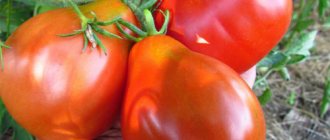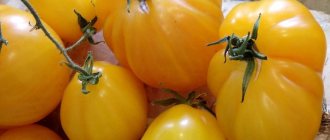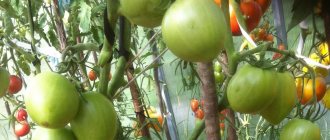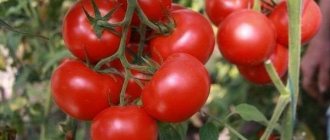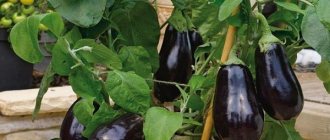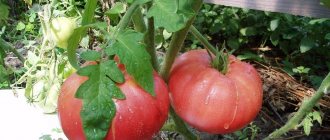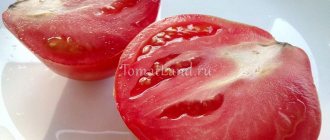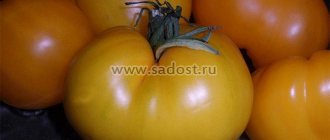Japanese crab is the result of breeding activities of scientists from Barnaul (agricultural company Demetra-Siberia). It appeared in the State Register in 2007 as a variety for cultivation in greenhouse conditions and in open-air beds. The secret is in its original form: the ribbed slices look like crab claws.
| Height | Landing location | Ripening time | Fruit color | Fruit size | Origin | Fruit shape |
| Tall | Greenhouse, Open ground | Mid-season | Pink | Large | Variety | Flat-round |
Productivity
The Japanese crab enters the fruiting phase in the middle period, 110...115 days after emergence. But more than once, according to gardeners, the period of waiting for the first fruits to appear lasts up to 125 days. It is possible that this indicator is influenced by the landing site. It has been proven that in greenhouse conditions the Japanese crab develops faster and bears fruit more abundantly.
The bush produces no more than 3 tomatoes in each cluster. The variety is characterized by extended fruiting; in some regions, tomatoes from its bushes are harvested until November. The maximum yield (subject to cultivation in a greenhouse and standard care) is 15 kg/m2; 5 kg of sweet tomatoes can be harvested from one bush.
What are the advantages of the variety?
- Tomatoes are quite resistant to diseases characteristic of nightshade crops.
- The fruits are amazingly tasty, incomparable. This is what people who grow Japanese crab say.
- Highest seed germination rate. Practice shows that only 5% of seed material does not germinate.
- The Japanese crab tomato variety perfectly tolerates sudden and significant changes in air temperature and does not react to the nature of the weather.
No particular disadvantages have been identified for this variety. But when talking about the advantages and disadvantages of tomatoes, gardeners point out that the variety is very demanding in care and cultivation.
Landing
So, without strict adherence to all the rules of agricultural technology, you will not be able to boast of the good yield of Japanese crab tomatoes.
Growing tomatoes of this variety is possible only by seedlings. Preparing seeds for sowing is done slightly differently than for other varieties
Before planting, it is very important to soak the seeds for two, or better yet, three days, first in a weak solution of potassium permanganate, and then in any root formation stimulator. After this period, the seeds should swell slightly
Sowing should begin on March 8 - 10, this is very important! This can be done in containers or peat pots. Seeds should be buried 1 cm into the soil
After which the container should be covered with a transparent film and placed in a bright, warm place. It is better to moisten the soil through a tray. After the shoots emerge, the film must be removed. You can plant the sprouts in separate cups when they have two leaves.
It is important to know that the optimal time for planting seedlings in open ground is 65 days after sowing the seeds. That is, in early May, tomatoes can be planted in beds or in greenhouses
The variety is extremely sensitive to planting density. You cannot place more than 4 bushes on one square meter.
Don't grow tomatoes where peppers, eggplants or potatoes used to grow.
Japanese crab tomatoes develop best in loamy soil rich in nutrients.
Growing
The peculiarity of these tomatoes is that they are demanding when it comes to watering rules. They do not tolerate drought, and they can only be watered with warm water at the root in the early morning or at sunset.
The stems should be tied to strong supports, otherwise the bushes will simply fall.
You can leave only two stems on each bush, and cut off all the stepsons at a distance of 1 cm from the trunk.
The Japanese crab variety has an interesting characteristic. It can live without leaves, like vines. Of course, this does not mean that the leaves need to be torn off. However, it is worth removing some of them in such a way that air circulates well between the bushes.
Pros and cons of Japanese crab tomato
The Japanese crab tomato variety has quite significant advantages, thanks to which it is so loved by Russian gardeners:
- excellent taste of the fruit;
- large fruit;
- unusual interesting shape of tomatoes;
- high productivity;
- extended fruiting;
- the possibility of manually collecting seeds for planting next season;
- resistance to crown and root rot, tobacco mosaic.
However, there are some disadvantages:
- susceptibility to late blight and cladosporiosis at high air humidity;
- falling of flowers and ovaries at low ambient temperatures (applies only to open ground conditions);
- average commercial qualities, characteristic of many sweet salad varieties (short shelf life of ripe fruits, average transportability).
Proper care of Japanese crab bushes will neutralize the first two disadvantages. Therefore, planting this variety is recommended for gardeners who have experience in growing tomatoes.
Tomato care
In the process of caring for Japanese crab tomatoes, you will have to do the following work:
- regular watering. It is not recommended to overdo it, because excess moisture causes fungal diseases of the plant - late blight, blackleg, nematode. 2-3 waterings per week will be enough;
- loosening the soil and removing weeds;
- tying stems during the growing season. Sometimes additional support is required for large fruit clusters;
- feeding plants with complex mineral and organic fertilizers;
- prevention and treatment of tomato diseases, pest control (Colorado beetle, caterpillars and whitefly butterfly).
Some gardeners mulch their tomato beds. This allows you to avoid loosening the soil after each watering. Sawdust, crushed last year's leaves and dry grass without seeds are used as mulch.
Japanese crab is a crop that, with proper care, can produce a good harvest of large, beautiful and tasty tomatoes. And it doesn’t matter that they don’t last long, because you can make a lot of delicious things from them.
Features of cultivation
The Japanese crab tomato is grown in seedlings. The timing of sowing is determined depending on the region in which the site is located and the planting location.
When calculating the optimal sowing time, the recommended age of seedlings is also taken into account - 55...60 days.
Seedlings are planted in well-fertilized greenhouse or open beds according to a 50x40 cm pattern. Thus, 3...4 bushes will be located per 1 m2 of area.
It is not recommended to thicken the plantings: the Japanese crab bush is quite powerful, bears large fruits, and therefore needs a sufficient feeding area. When planting thickly, there will be competition for nutrients in the soil, which will not have a very positive effect on the yield.
Before planting the seedlings, after forming the planting holes, you need to think about the support. Plants are tied to a trellis or stakes. Since the height of the Japanese crab is impressive - from 1.5 m or more, the stem can simply break under the weight of the fruit without additional support.
As the bushes grow, pinching is carried out. Moreover, initially you can leave only one stem or form a second one with the help of a powerful stepson. The maximum yield of the bush is achieved by forming 1…2 stems. All other lateral processes are promptly removed.
To prevent tomatoes from getting brown spot and late blight, it is recommended to treat them for preventive purposes. There are many folk recipes, as well as biological products that do not contain chemically harmful substances, so preventive treatments can be carried out right up to the harvesting of fruits.
When growing tomatoes in protected soil, it is important to observe the recommended air humidity - 60...70%. One way to reduce humidity in a greenhouse is mulching.
Since one of the disadvantages of the variety is the tendency to shed flowers and ovaries when it gets cold in open ground, it is necessary to provide them with temporary shelter in a timely manner. In addition, you can spray the flowers with a solution of the “Ovary for Tomatoes” preparation.
In addition to its main function (increasing fruit set in flowers), this drug has several more - it helps plants under stress to stop dropping flowers and fruits, and builds resistance to stress.
When growing, do not forget about standard care measures: watering, loosening, fertilizing, hilling.
Pest and disease control
Taking into account the extended fruiting of the cultivar, preventive measures are being taken to extend the growing season. Before planting, the soil in the greenhouse is disinfected with the preparation “Baikal” or “Fitosporin”. Seeds are pickled in a solution of potassium permanganate or hydrogen peroxide.
At the beginning of the growing season, the bushes are sprayed with a 1% solution of Bordeaux mixture or other copper-containing fungicide.
On hot days, aphids often appear on tomatoes. At the beginning of summer, you can spray the plant with an insecticide. During the fruiting period, folk remedies with a soap base are used.
Thrips and whitefly are more dangerous for tomatoes grown in a greenhouse. Effective pest control products: “Confidor”, “Aktara”.
The biological insecticide Fitoverm has low toxicity. The period of complete disintegration is three days; it remains in the stomachs of insects for 7-20 days. The drug is effective at air temperatures above 18˚C.
However, low night temperatures and prolonged inclement weather can cause late blight, and too much humidity at high temperatures can cause cladosporiosis. At the first signs of disease, you need to treat the plants every three days with special means (ash, trichopolum or phytosporin in the first case and copper-containing preparations in the second).
In the southern regions, the plant's resistance to unfavorable conditions is clearly excessive, so the variety is still recommended for regions with a sharply continental climate. Despite the relative youth of the variety - it has been cultivated for only a dozen years - “Japanese Crab” has already been appreciated by summer residents and tomato lovers. We hope it will take root in your garden too!
This variety does not belong to the early category, so it is quite possible that it may be affected by late blight. After all, this disease actively progresses in August, when a sharp difference in day and night temperatures begins. The likelihood of cladosporiosis also increases with high humidity and temperature conditions.
Therefore, in order to preserve the harvest, it is necessary to carry out preventive spraying of the bushes, starting in June. The first treatment should be done 2-3 weeks after planting the seedlings in the ground. The remaining two - every 10-14 days, depending on weather conditions.
The following products should be used for spraying:
"Ridomil Gold";
"Quadris";
"Revus."
Reviews from gardeners who planted
Gardeners simply love to share their experience of growing certain varieties and hybrids of tomatoes, leave reviews and comments, and discuss details on forums. Below are several reviews of the Japanese crab tomato.
nechaevatu, Perm region:
“I have been growing tomatoes for more than 10 years, during which time I have tested more than 200 varieties. Many had to be weeded out, and as a result I chose 11 favorite varieties and 5 hybrids. One of my favorites is Japanese crab. Almost all tomatoes grow up to 350 g, but we managed to grow a tomato weighing 720 g.
The bushes are grown in open ground in risky farming zones and have always shown excellent yields. The exception was the 2014 season, when the fruits set poorly due to low temperatures (in June of that year the temperature dropped to +20).“
Maria Novikova, Safonovo:
“Japanese crab is an excellent salad variety with an incredibly sweet taste. Grown in 2021. The bushes grew powerful, the fruits sat so firmly on the branches that they had to be cut off with a knife. In my opinion, the yield was low: the fruits grew large, but in small quantities. During flowering, most of the flowers dried out and fell off, although I treated them with boric acid and the preparations “Tsveten” and “Tomaton.”
Marusev V.P., Tver:
“In general, I don’t really like pink tomatoes, but the appearance of the Japanese crab fruit on the package of seeds seemed so interesting to me that I couldn’t resist and bought 1 bag. The variety really surprised me: the tomatoes grew large, sugary, and in large quantities. Next season I will allocate more space for them in my greenhouse.”
Tamara, Tula:
“I love this variety - large, sweet, productive, unusual. They have been growing for 3 seasons in a row. You have to collect seeds from your own tomatoes yourself, because when buying seeds, mis-grading often occurs.”
How to grow seedlings
To get seedlings, sow the seeds in the first ten days of March, but remember that under favorable conditions, the tomatoes will quickly begin to stretch and will be too tall by the time they move to the beds.
Seed preparation
Preparation will help you speed up seed germination, reduce the risk of infections, and increase tomato yields.
First of all, select the planting material. Pour out the grains and examine them - discard the small, crooked and empty seeds. Prepare a saline solution: dissolve a tablespoon of salt in a glass of water. Drop the seeds into it. After 15-20 minutes, remove the grains that have floated to the surface and throw them away, and take the ones that have sunk to the bottom for planting.
Warm the seeds: spread them on cotton cloth or newspaper, in bags and place them on the radiator.
Disinfect planting material. Prepare a 1% solution of potassium permanganate: dissolve a teaspoon (without top) of potassium permanganate in three glasses of water. Place the seeds in the solution for 15-20 minutes, then rinse them with running water.
Place the seeds in warm water (26-30 degrees) and stir hourly for 15-18 hours (if you have an aquarium compressor, use it). This procedure is called bubbling - oxygen enrichment. The process increases the germination and growth of the crop.
Soak the seeds in water or biostimulants: at a temperature of 20 degrees for 12 hours. Popular biostimulating drugs among Russian summer residents: “Zircon”, “Epin”, “Immunocytophyte”.
Wrap the seeds in cotton cloth and plastic and place in the refrigerator for 8 hours. Remove to a warm room for 8 hours. Repeat changing temperatures 5-6 times. Hardening off will help grow frost-resistant bushes. According to farmers, yields will increase by 30%.
Place the seeds, wrapped in cheesecloth, on a flat dish (saucer or Petri dish). Constantly moisten the fabric with warm water (25 degrees). When embryos 2-3 mm in size appear, sow the seeds in the ground.
Container and soil
Use plastic cups, containers, and bottles as containers for seedlings.
Buy universal tomato soil at the store. It includes:
- humus;
- peat;
- river sand.
You can prepare the soil mixture yourself. To do this, mix:
- 1 part of soil from the garden (take from the area where cucumbers, zucchini, carrots, dill grew);
- 2 parts non-acidic peat (pH 6.5);
- 0.5 parts sand (river or washed);
- 1 part humus or sifted mature compost.
Add wood ash (dolomite flour), sphagnum moss and fallen pine needles.
Disinfect both the soil and containers before use with a solution of potassium permanganate or heat them in the oven at 200 degrees.
Sowing
Bury the seeds into the ground 1-1.5 cm, spray with water from a spray bottle, cover the containers with film or glass and put them in a warm, well-lit place.
Growing and care
When sprouts appear, remove the film. Water with a spoon or syringe, being careful not to get it on the plants.
In the phase of 3-4 true leaves, pick. Add mineral fertilizer to the new soil (1 tbsp per 5 liters of soil). Plants are planted in separate containers and dripped down to the cotyledon leaves. 10 days after transplantation, feed with complex fertilizer. Repeat feeding every two weeks.
When watering, avoid getting water on the stem and leaves.
Harden the seedlings, so the tomatoes will quickly get used to new conditions and will be able to withstand sudden temperature changes and night frosts more easily. 2-3 weeks before moving, start taking the seedlings out into the open air: in the first days for 3-4 hours, in the last days leave them overnight.
Description of the variety
The originators of tomatoes were agro breeders from Barnaul. In 2007, the variety was registered in the State Register of the Russian Federation. The description of the tomatoes states that they are suitable for growing in greenhouse conditions and in open ground throughout the country.
Distinctive features
An indeterminate variety, in open ground the bushes reach a height of 100-120 cm, in greenhouses - 200 cm. The first flowers form above the 7-8 leaf, 6-10 ovaries grow on each brush. The leaves are light green and medium in size. The fruit ripening period is average, we get the first tomatoes 110-115 days after the sprouts appear.
Fruit characteristics and yield
The fruits of the Japanese crab are of a rich pink hue, round, flattened to the stalk. Tomatoes got their name from their ribbing - the pronounced segments resemble the claws of a crustacean.
Other fruit characteristics:
- not dense, but fleshy, juicy pulp;
- pleasant tomato taste and aroma;
- pronounced sugar content;
- 5-6 seed chambers;
- weight from 250 to 350 g.
Tomato yield is up to 11 kg per 1 sq.m (from four bushes).
